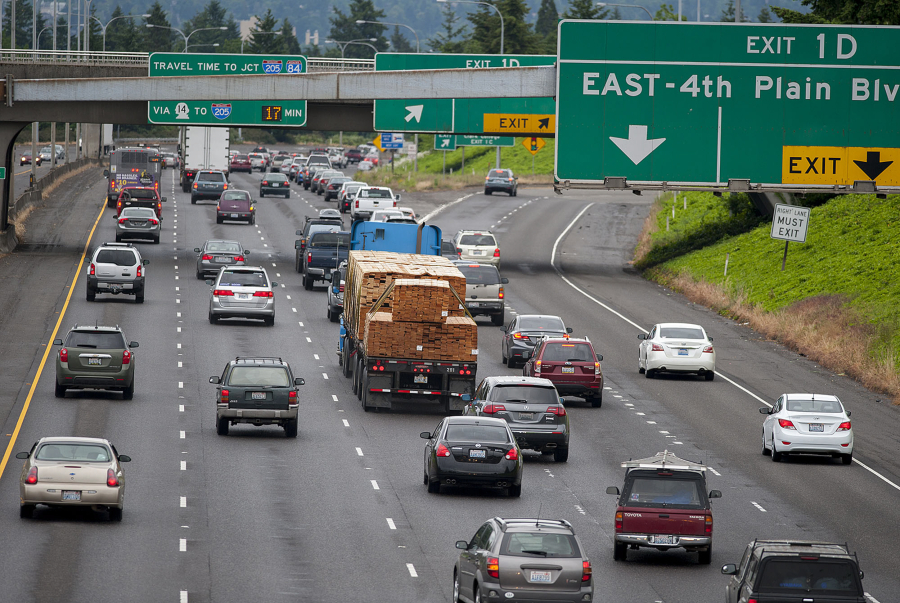Clark County resident Natalie Richards is one of thousands of Portland-bound commuters who finds herself frustrated and stuck in bumper-to-bumper traffic.
Richards, a civil engineer and project manager, rides the bus across the Columbia River, but it’s done little to save time. In fact, she found herself having to leave earlier and earlier to make it to work by 8 a.m.
“When the gas price went down all the cars hit the road at 5:30 too … We were stuck behind all these single-driver cars,” she said.
Now she and a group of 16 others have been championing High Occupancy Vehicle lanes on the southbound stretch of Interstate 5 in hopes that they would bring some reprieve for carpools and mass transit riders.
Officials say HOV lanes can be a solution to congestion, but not on southbound I-5 in its current configuration.
From October 2001 until August 2005, the Washington State Department of Transportation ran a pilot project with an HOV lane on southbound I-5. The lane ran between Northeast 99th Street and Mill Plain Boulevard and was limited to buses, carpools and motorcyclists from 6 to 8 a.m. weekdays. It was the first HOV lane in Washington outside of Puget Sound.
“We were a little four-mile isolated lane,” then-WSDOT spokeswoman Jilayne Jordan said in an August 2005 interview with The Columbian. “There just wasn’t enough benefit to entice motorists in the Vancouver area to give up their cars.”
During its run, the HOV pilot program hit five of eight goals established by WSDOT. HOV users and C-Tran buses enjoyed higher speeds and faster commutes, but they weren’t enough to convince many single-occupancy drivers to carpool or ride the bus. Also, drivers in the two all-traffic lanes dealt with longer commutes, which prompted a lot of criticism of the HOV concept.
The lanes functioned more like a queue jump rather than a true HOV lane system. But Mark Hallenbeck, director of the Washington State Transportation Center at the University of Washington, said that would have been fine if there would have been many buses going to Portland and lots of people riding them.
“Transit use is the big way you get lots and lots of people in an HOV lane,” he said. Another option Hallenbeck suggested was making it an HOV and toll lane, or HOT lane, adding that neither is something Clark County would likely embrace.
“You as a county have a pretty negative attitude toward buses and you have a negative attitude toward anything that has to do with taxes or government,” he said.
He likened the traffic problems on southbound I-5 to a Soviet breadline. There’s no pricing mechanism to get people to be more conservative with how they use the amenity, in this case the freeway, and no revenue stream to enhance it, he explained.
“We’re communists when it comes to roads, we’re not capitalists,” he said. “So if you want to use I-5 you go early and you stand in line.”
And lots of drivers do.
The Regional Transportation Council counted more than 297,000 vehicles daily crossing the Columbia River on I-5 and I-205 in 2016. During the typical morning commute last year, vehicles flooded the roadways and traffic crawled across the Interstate 5 Bridge and its approach at 9 mph.
RTC Executive Director Matt Ransom said HOV lanes can be a tool to address traffic problems, but are best applied over long stretches of road.
“It’s best implemented in a comprehensive strategy,” he said. “A short segment may not have a lot of utility.”
In the near term, transportation agencies are looking at other ways to reduce congestion in busy corridors, he said. WSDOT is looking at metering more onramps during peak periods. RTC is studying the feasibility of a pilot project that would allow C-Tran buses to run on the shoulder of Interstate 205 and state Highway 14, which could potentially be implemented on I-5 in the future.
“We’re working with what we have out there knowing massive capital improvements cost a lot and don’t come around all time,” Ransom said.




